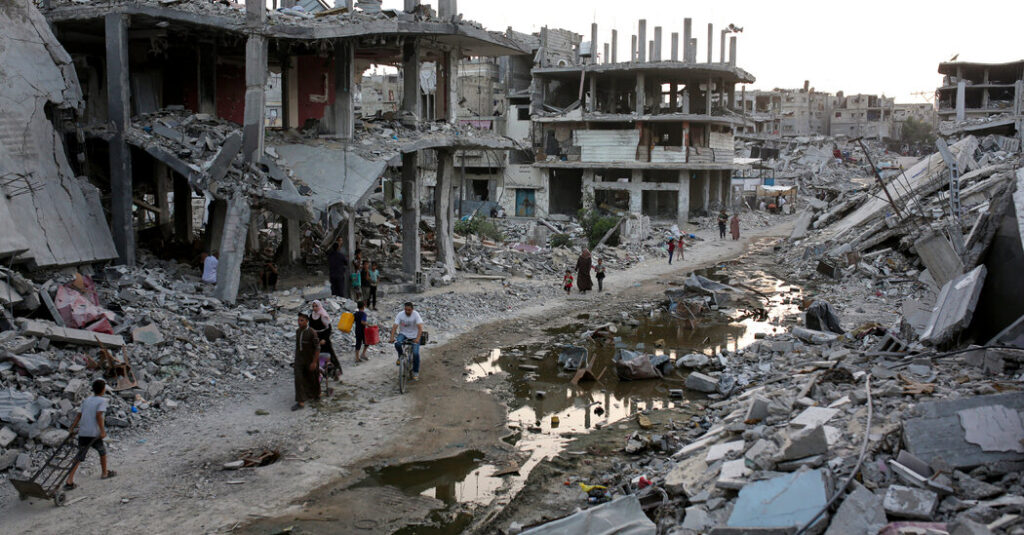Hamas has softened its stance on the latest Gaza cease-fire proposal but is sticking to a key demand that has been a major obstacle to a deal, two senior officials from countries involved in the negotiations said.
That dampened prospects for an imminent deal, even as U.S. and Israeli officials expressed optimism that talks were making progress after weeks of deadlock.
Hamas made a counterproposal on Wednesday. Hamas wants assurances from the international community that once an initial truce begins, the two sides will continue talks until a final deal is reached to end the war and release all hostages in Gaza, two officials said.
In reality, one official said, Hamas wants to ensure that it does not hand over many hostages just to restart the war with Israel. Both senior officials spoke on condition of anonymity because they were not authorized to speak publicly.
Israeli negotiators immediately rejected the request, two officials said. Israel wants to have the option to resume fighting if it deems it necessary. One official believes that without such leverage, Hamas could drag its feet, effectively achieving an undeclared permanent ceasefire.
At the heart of the dispute is the future of Gaza. Israeli Prime Minister Benjamin Netanyahu has vowed to destroy Hamas and overthrow its rule in the Palestinian enclave. Hamas hopes a permanent ceasefire will keep it in power.
Israeli military leaders are now increasingly saying a deal to bring home the remaining 120 hostages is the right way forward, even if it comes at the cost of keeping Hamas temporarily in power.
The talks are based on a three-phase structure first announced by President Biden in late May and later endorsed by the United Nations Security Council.
The two sides agreed on the outlines of a deal that would include a six-week ceasefire and the release of most civilian hostages in exchange for Palestinian prisoners.
During the pause, Israel and Hamas will negotiate the next step: ending the war and releasing the remaining living hostages, most of them soldiers.
The debate now is what happens next.
With a possible deal in place, CIA Director William J. Burns will travel to Doha next week to meet with intelligence chiefs from Israel, Europe and other countries to discuss the matter, according to three people familiar with the matter. ceasefire agreement.
Burns may also travel to Israel to put pressure on the Israeli government to reach a deal.
U.S. officials believe the current revisions to the deal, which lay out precise conditions for transitions between the deal’s phases, may be enough to begin releasing hostages held captive for months.
But even if Israeli negotiators are able to reach a deal to end the war in Gaza, it’s unclear whether Netanyahu’s government will support it. Two senior members of his coalition have ruled out a comprehensive ceasefire, and Netanyahu himself has publicly hesitated to support the framework.
According to Israel, about 120 hostages remain in Gaza, out of some 250 people kidnapped in Hamas-led attacks. Israeli authorities speculate that about a third of them are dead.
During a week-long truce in November, 105 people were released in exchange for 240 Palestinian prisoners, but Hamas has refused to release more hostages without a path to a permanent ceasefire.
On Friday, an Israeli delegation led by Mossad intelligence chief David Bania arrived in Qatar for the first time in weeks for further talks. Mr Baniya met with Qatari Prime Minister Mohammed bin Abdulrahman bin Jassim Al Thani, who serves as one of the main mediators.
But Bania did not arrive with other top Israeli security chiefs tasked with hammering out the deal, an unusual arrangement. He was accompanied by Ophir Falk, a close aide to Mr Netanyahu, two senior officials said.
The Israeli military and Shin Bet intelligence services involved in the negotiations declined to comment.
Hamas did make one key concession in its counterproposal, softening its position on the terms of the second phase of ceasefire negotiations. The group had wanted the talks to focus solely on which Palestinian prisoners were released in exchange for hostages.
Officials said Qatar had put pressure on Hamas for weeks before it backed down, with much of the armed group’s political leadership based in Doha.
But at the same time, two officials said Hamas is demanding assurances from mediating countries, including the United States, that negotiations during the ceasefire will continue until a permanent ceasefire is negotiated and all living hostages are released.
Israeli negotiators have agreed to extend the six-week truce as long as talks make progress. A senior official said Hamas’ new language could be interpreted as allowing those talks – and the initial truce – to continue indefinitely.
At the meeting in Qatar, Baniya said Hamas’ demands would be radically different from proposals passed by the U.N. Security Council and Biden, the senior official said.
Israeli military operations in Gaza continued in the enclave on Saturday as ceasefire talks progressed. Israeli planes struck the area of a United Nations school in Nuserat, central Gaza, where the Israeli military claimed Palestinian militants had been operating. The attack killed at least 16 people and injured dozens more, according to Gaza’s health ministry, which does not distinguish between civilians and combatants.
The school has become a shelter for displaced people seeking safety, the ministry added. The Israeli military said it was doing its best to avoid civilian casualties and accused Hamas of operating in areas where civilians in Gaza are concentrated.

